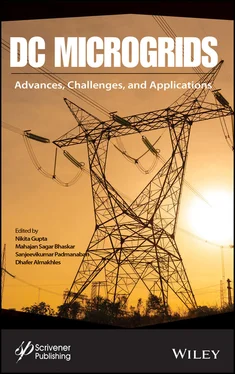Chapter 1discusses DC microgrid protection challenges, fault detection methods, and design criteria for an efficient protective system. DC micro-grid protection strategies and both line-to-ground and line-to-line faults, besides their impacts, are reviewed. Also, DC fault current interrupting devices are presented. Chapter 2provides a comprehensive overview of different existing control schemes for DC microgrids, along with the motivation and challenges behind them. It covers the basic and multi-level control schemes in detail, along with the converter control scheme for solar, wind, battery, and fuel cell-based systems. Chapter 3describes different basic fault detection, location, and islanding detection methods for DC microgrids, along with the advantages and disadvantages of the schemes. Chapter 4proposes an optimized energy management system for a micro-grid consisting of solar and wind generation units, an energy storage system, and a diesel generator. An optimization model for the energy management system was developed to minimize the overall operating and maintenance costs for the real power flow in the microgrid. The optimization was done using genetic algorithms and pattern search algorithms and a comparison is made based on the total operating and maintenance costs for real power flow. Chapter 5presents the literature review of various energy management strategies involving energy storage in a microgrid, and a case study is presented by optimizing the involved objective functions using the linear programming method for a residential microgrid. The optimal operating mode is decided hourly to get the optimal cost. Chapter 6presents the design of a hybrid renewable energy system using parameters such as available solar radiation, available hydro potential, demand assessment, etc., for DC microgrid application. The present study developed a systematic approach for solar and hydro potential assessment for DC microgrid applications. Chapter 7details the influence of line equivalent resistances on power-sharing and on average DC bus voltage errors caused by droop techniques, reviewing the secondary control methods proposed in the literature to correct such errors. Moreover, two secondary control techniques based on distributed control, proposed by the authors, are highlighted, as well as the design of the communication system. Chapter 8discusses the improvement of power electronic interface performance using dynamic analysis. An improved pole clustering method is proposed for dynamic analysis of quadratic boost converters with switched inductor cells only to unravel the resolvent matrix and prove the methodology’s easiness. Additionally, a view of various controllers applied to DC-DC converters is given for researchers to have as a guide for their analytical study of mathematical modelling. Chapter 9presents a detailed study of the matrix converter. The control of a multiphase matrix converter for multiphase drive applications is discussed to make the system more reliable. A brief description of each part of the drive system fed from the matrix converter is presented. Moreover, several issues associated with the matrix converter, such as modulation, control, and mitigating effects of non-idealities, are discussed. The different applications, especially in more electric aircraft applications, wind power conversion, and applications in electrical drives, are also discussed. Chapter 10proposes an Active Neutral-Point Clamped Multilevel Inverter that has the advantages of both flying capacitors and neutral point-clamped multilevel inverters, such as flexibility of switching redundancy and robustness to produce multilevel voltages. The operation of the proposed Active Neutral-Point clamped multilevel inverter is explained in detail. Chapter 11presents a quasi-Z-source network-based DC-DC converter with a quadratic voltage conversion ratio that applies to photovoltaic systems and DC microgrids. In Chapter 12, a typical multiterminal VSC DC microgrid for the study is proposed, with careful consideration of topology design and grounding mode selection. Then the DC fault characteristics of a multi-terminal DC microgrid are analyzed, including DC unipolar fault and DC bipolar fault, and are used as the theoretical basis for protection configuration. Integrated control and protection platform are introduced, on which a layered setting of protection action delays and some supplementary control measures, such as de-blocking the VSCs and re-closing the DC breakers in the non-fault area, can be implemented. In Chapter 13, a decision tree-based protection scheme is designed for fault detection/classification and faulty section identification of DC microgrids during a faulty condition. The simple structure of the decision tree allows for achieving high accuracy in executing the protection task. The proposed algorithm is based on the acquisition of the voltage and current signals from the relaying buses. In Chapter 14, various passive and active islanding methods are discussed along with their merits and demerits, and individual lower-order harmonics are investigated along with the static transfer switch, which, as a new effective passive islanding method, is proposed for the inverter centered utility connected system.
Nikita Gupta, Mahajan Sagar Bhaskar,Sanjeevikumar Padmanaban and Dhafer AlmakhlesEditors
Конец ознакомительного фрагмента.
Текст предоставлен ООО «ЛитРес».
Прочитайте эту книгу целиком, купив полную легальную версию на ЛитРес.
Безопасно оплатить книгу можно банковской картой Visa, MasterCard, Maestro, со счета мобильного телефона, с платежного терминала, в салоне МТС или Связной, через PayPal, WebMoney, Яндекс.Деньги, QIWI Кошелек, бонусными картами или другим удобным Вам способом.
